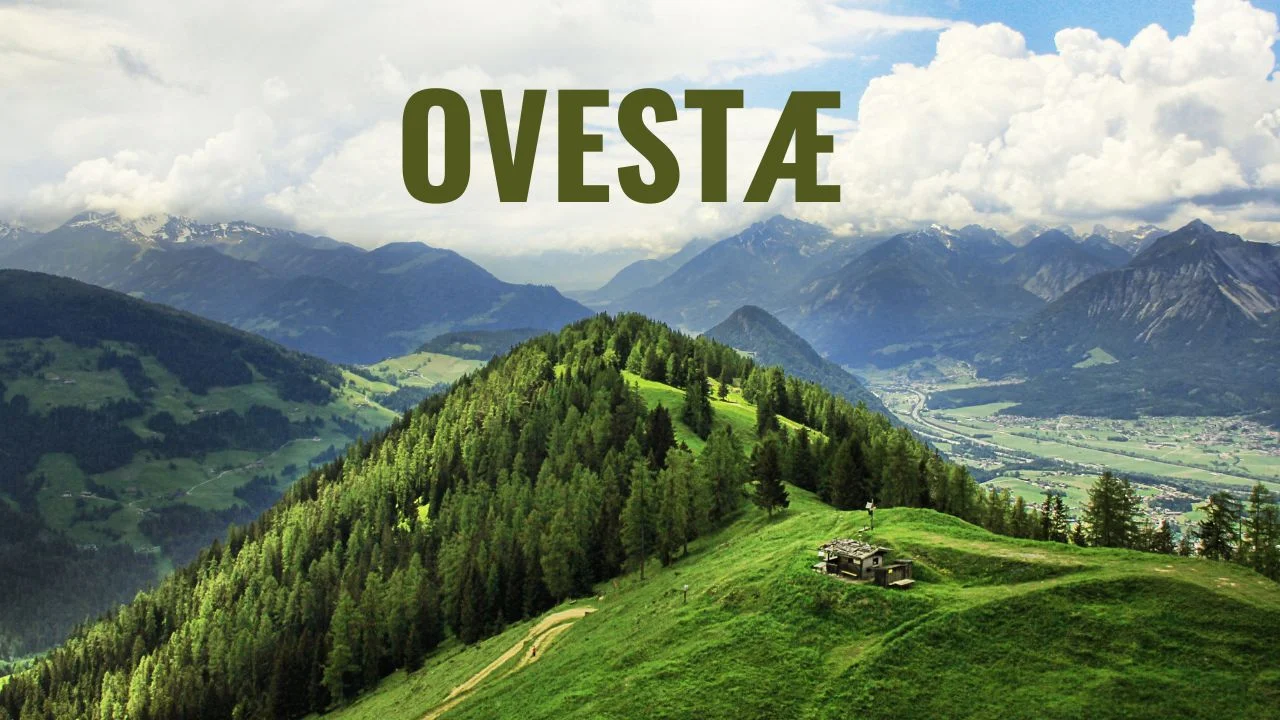Life style
Ovestæ: Bridging Tradition and Innovation for a Harmonious Future
Published
1 month agoon
By
Rocklord
In a world increasingly driven by rapid technological advancements and shifting cultural landscapes, the emergence of Ovestæ represents a compelling fusion of tradition and innovation. This concept, rooted in the idea of bridging age-old practices with modern ingenuity, aims to create a harmonious future where the wisdom of the past and the possibilities of the future coexist and enrich each other.
The Concept of Ovestæ
Ovestæ, derived from the Latin words “ovum” (egg) and “vestigium” (footprint), metaphorically represents the idea of nurturing new growth from foundational traditions. It embodies the belief that innovation does not necessarily mean discarding the old but rather integrating and evolving it in ways that honor its origins while adapting to contemporary needs.
The Significance of Tradition
Tradition often holds the key to a deep understanding of cultural, environmental, and societal practices. For centuries, traditional knowledge has guided communities in sustainable agriculture, holistic health, and social cohesion. These time-tested practices, whether it’s a farming technique developed over generations or medicinal remedies passed down through families, embody a richness of experience and adaptability.
In the context of health, traditional medicine systems like Ayurveda or Traditional Chinese Medicine (TCM) offer valuable insights into natural remedies and holistic approaches that have been validated over time. Similarly, indigenous agricultural methods often emphasize biodiversity and ecosystem balance, which are increasingly relevant in the face of modern environmental challenges.
The Role of Innovation
Innovation, on the other hand, is about pushing boundaries and exploring new frontiers. Technological advancements in genetics, biotechnology, and artificial intelligence present unprecedented opportunities to address global challenges, from disease prevention to climate change. By harnessing these innovations, we can develop solutions that not only enhance our capabilities but also address pressing issues in more effective ways.
For instance, the integration of genetic research with traditional agricultural practices can lead to the development of crops that are more resilient to climate change while maintaining traditional qualities that are valued in local cuisines. Similarly, advances in biotechnology can offer new methods of synthesizing traditional medicinal compounds, making them more accessible and effective.
Harmonizing Tradition and Innovation
Ovestæ seeks to create a harmonious synergy between tradition and innovation. This approach involves:
- Respecting and Preserving Traditions: Understanding and documenting traditional practices is crucial. By preserving these practices, we maintain a connection to our heritage and ensure that valuable knowledge is not lost.
- Integrating New Technologies: Applying modern technologies to enhance traditional practices can lead to groundbreaking results. For example, using data analytics to optimize traditional farming methods can increase yields and sustainability.
- Fostering Collaboration: Encouraging dialogue between traditional practitioners and modern scientists or technologists can lead to innovative solutions that respect cultural contexts while addressing contemporary needs.
- Educating and Empowering Communities: Educating communities about the benefits of integrating traditional and modern practices can empower them to make informed decisions that benefit both their cultural heritage and their future prospects.
Examples of Ovestæ in Action
Several initiatives around the world exemplify the Ovestæ approach:
- Sustainable Agriculture: In India, efforts to combine traditional organic farming methods with modern technologies have led to more resilient crops and improved soil health, enhancing food security while respecting traditional practices.
- Health and Wellness: In various parts of the world, researchers are exploring how traditional medicinal herbs can be enhanced using modern scientific techniques to create more effective treatments.
- Cultural Preservation: Projects that use digital technology to document and share traditional crafts and languages are helping to preserve cultural heritage while making it accessible to a global audience.
Conclusion
Ovestæ represents a hopeful vision for the future where tradition and innovation are not seen as opposing forces but as complementary elements that, when combined, can create a more balanced and sustainable world. By respecting the wisdom of the past and embracing the possibilities of the future, we can build a harmonious future that honors our heritage while addressing the needs of the present and future generations.
This balanced approach offers a promising path forward, where the richness of tradition and the excitement of innovation come together to create a brighter, more harmonious future for all.
FAQs
1. What is Ovestæ?
Ovestæ is a concept that embodies the fusion of traditional practices with modern innovation. It represents the idea of nurturing new growth and solutions by integrating time-honored wisdom with contemporary advancements to create a balanced and harmonious future.
2. Why is Ovestæ important?
Ovestæ is important because it seeks to create a synergy between the wisdom of traditional practices and the possibilities of modern technology. By bridging these areas, Ovestæ aims to address contemporary challenges more effectively while preserving valuable cultural and historical knowledge.
3. How does Ovestæ work in practice?
Ovestæ works by:
- Respecting and Preserving Traditions: Documenting and honoring traditional knowledge and practices.
- Integrating New Technologies: Applying modern technological advancements to enhance and evolve traditional methods.
- Fostering Collaboration: Encouraging dialogue and cooperation between traditional practitioners and modern scientists or technologists.
- Educating and Empowering Communities: Providing education on the benefits of combining traditional and modern practices, helping communities make informed decisions.
4. Can you give examples of Ovestæ in action?
Yes, some examples include:
- Sustainable Agriculture: Combining traditional organic farming methods with modern technology to improve crop resilience and soil health.
- Health and Wellness: Using modern scientific techniques to enhance traditional medicinal herbs for more effective treatments.
- Cultural Preservation: Employing digital technology to document and share traditional crafts, languages, and practices.
5. How does Ovestæ benefit communities?
Ovestæ benefits communities by:
- Preserving Cultural Heritage: Ensuring that traditional knowledge and practices are not lost and are integrated into contemporary contexts.
- Enhancing Sustainability: Combining traditional methods with modern technologies to address environmental and resource challenges more effectively.
- Improving Quality of Life: Integrating traditional health practices with modern medical advancements to provide better health outcomes.
6. What are the challenges associated with implementing Ovestæ?
Challenges may include:
- Resistance to Change: Some communities or individuals may be resistant to integrating modern technologies with traditional practices.
- Balancing Modern and Traditional Needs: Ensuring that the integration respects the integrity of traditional practices while effectively incorporating modern innovations.
- Resource Constraints: Limited resources or funding may hinder the implementation of Ovestæ initiatives.
7. How can individuals contribute to Ovestæ?
Individuals can contribute to Ovestæ by:
- Learning About and Supporting Traditional Practices: Gaining knowledge about traditional methods and supporting their preservation.
- Advocating for Integration: Promoting and supporting efforts that combine traditional and modern approaches.
- Participating in Collaborative Projects: Engaging in projects or initiatives that work to harmonize tradition and innovation.
8. Where can I learn more about Ovestæ?
To learn more about Ovestæ, you can:
- Explore Academic Research: Look for studies and publications on the integration of traditional and modern practices.
- Follow Relevant Organizations: Engage with organizations and initiatives dedicated to blending tradition and innovation.
- Participate in Community Events: Attend workshops, seminars, or conferences that focus on Ovestæ-related topics.
9. Is Ovestæ applicable globally, or is it specific to certain regions?
Ovestæ is a global concept that can be applied anywhere. While the specific practices and traditions involved may vary by region, the overarching principle of harmonizing tradition with innovation is universally relevant and adaptable to different cultural and geographic contexts.
10. How can I get involved in Ovestæ initiatives?
You can get involved in Ovestæ initiatives by:
- Joining Local or Global Projects: Seek out and participate in projects or organizations that focus on integrating traditional and modern practices.
- Volunteering or Contributing Expertise: Offer your skills, knowledge, or time to initiatives that align with the Ovestæ philosophy.
- Advocating and Raising Awareness: Share information about Ovestæ and its benefits within your community and networks.
You may like
Life style
Resources for Operating a Successful Food Truck
Published
1 week agoon
September 13, 2024By
Rocklord
The mobile food industry has had an extraordinary boom over the last decade, and food trucks are at the heart of this gastronomic revolution. Committing to this business venture requires a strong foundation and a reliable framework for success—tools, branding, and understanding the legalities. Keep reading to discover industry insights and strategies to thrive in this dynamic market.
Navigating Health Codes and Food Truck Regulations

No food truck can operate legally without adhering to city and county health codes and regulations. Acquainting yourself with these laws is not just mandatory, but can save you from costly penalties or a shutdown. Each locale will have its own specific set of rules covering food safety, truck operations, and permits.
Securing the proper licenses is a multi-step process that begins with understanding what’s required in your area. Typically, this involves a health department evaluation of your truck. This scrutiny ensures that your vehicle is fit for food service, adhering to sanitation and food handling guidelines.
Training and education for you and your staff on food safety practices are not just beneficial for compliance, but also for establishing your reputation for quality and care. This includes regular updates on health requirements since codes can change, reflecting new standards or community health concerns.
Crafting a Memorable Food Truck Brand and Menu

Your food truck’s brand identity and menu selection are the essence of your business, resonating with customers beyond the palate. A compelling name, eye-catching design, and a unique menu can set your mobile eatery apart in a competitive market. It’s about crafting a narrative that connects with your target audience and creates a lasting impression.
When developing your menu, focus on quality over quantity. A limited but distinctive menu that highlights your culinary strengths will be far easier to manage and can become your signature. It’s also crucial to consider the logistics of prep time—quick-to-serve dishes reduce customer wait times and can boost turnover.
Think seasonally when planning your menu for the freedom to incorporate local, fresh produce, which often translates to higher quality meals and a draw for health-conscious consumers. Also, pay attention to trends without losing the authenticity of your brand which can bring excitement and variety to your offerings.
Marketing Strategies for Food Truck Business Growth
Effective marketing is pivotal to growing your food truck business. Establishing an online presence through a compelling website, active social media profiles, and leveraging food apps broadens your customer reach exponentially. Digital marketing can drive brand awareness and bring your food directly to the screens of potential customers.
With the mobility of food trucks comes the unique opportunity for location-based marketing. Utilizing social media and real-time updates to announce your whereabouts can create a buzz and generate foot traffic—think of it as your moving billboard. Engaging with local events and festivals puts you on the map, quite literally.
Partnerships with local businesses and fellow food truck operators are also worthwhile. Collaborative events or cross-promotions can open your services to new markets. It’s a mutual relationship that benefits all involved and fosters a supportive community within the industry.
Essential Tools and Equipment for Your Food Truck Venture

Embarking on a food truck business begins with equipping your mobile kitchen with the right tools. Commercial-grade cooking appliances that are compact yet efficient will ensure that you can serve your menu items quickly without compromising quality. Whether it’s grills, fryers, or refrigeration systems, each piece of equipment must be chosen with your specific culinary needs in mind.
Storage and organizational solutions are also vital in maximizing your limited space. Cleverly designed compartments and shelving can help keep ingredients fresh and at hand. It’s not just about the kitchen; reliable point-of-sale systems and inventory management tools are equally important for smooth operations.
In addition to purchasing brand-new items, sourcing high-quality used equipment from trusted suppliers can be a cost-saving strategy for startup ventures. Suppliers like Los Angeles County Food Trucks provide entrepreneurs with the necessary machinery to kick-start their businesses within budget.
Overall, the journey to a thriving food truck business is rich with opportunities and challenges. By equipping yourself with solid resources, strategic branding, a clear understanding of regulations, innovative marketing, and sharp financial management, your road to success is well within reach. Remember, while passion drives your food truck venture, it’s persistent preparation and informed execution that will sustain it.
Life style
Faballeba: A Timeless Blend of Tradition and Style
Published
1 week agoon
September 13, 2024By
Rocklord
Throughout history, traditional garments have served as markers of cultural identity, artistic expression, and personal style. One such attire, Faballeba, has not only preserved the heritage of its origin but has also evolved into a versatile fashion statement. With intricate designs and deep-rooted cultural significance, Faballeba embodies the harmonious blend of past and present. In this article, we’ll dive deep into the world of Faballeba, exploring its origins, designs, and the ways it has influenced both traditional and modern fashion.
The Origins of Faballeba
Faballeba is more than just a piece of clothing; it is a narrative of cultural identity that dates back centuries. Originating from a blend of various regional garments, Faballeba began as a ceremonial attire worn during significant cultural events. Its earliest designs were rooted in spiritual symbolism, with colors, patterns, and fabrics carefully selected to represent the wearer’s social status, tribe, and life events.
Over time, Faballeba evolved from its ceremonial roots to become a staple in everyday wear for certain communities. While the original purpose of Faballeba was tied closely to religious and cultural practices, it gradually adapted to the changing demands of fashion, allowing wearers to express their individual identities while maintaining a connection to their heritage.
Cultural Significance of Faballeba
In its essence, Faballeba is a cultural emblem, representing not only the wearer’s personal style but also a larger connection to community, tradition, and history. Each Faballeba garment carries unique meanings through its colors, patterns, and construction techniques. Red might symbolize courage, while intricate embroidery might indicate craftsmanship passed down through generations. These subtle elements make Faballeba much more than a garment – it is a living artifact of a rich cultural legacy.
As the world becomes more interconnected, many are turning back to their cultural roots, and Faballeba has seen a resurgence in popularity. Whether worn during cultural festivals, weddings, or even as a modern fashion piece, Faballeba reminds wearers and onlookers alike of the importance of preserving traditions.
Faballeba in Fashion: A Modern Take
Modern fashion is constantly evolving, and so too is Faballeba. Contemporary designers have taken inspiration from traditional Faballeba styles, incorporating them into modern fashion in ways that appeal to today’s audience. By blending old and new elements, designers have crafted Faballeba-inspired pieces that are versatile enough for formal occasions while also lending themselves to everyday wear.
What sets Faballeba apart in the fashion world is its ability to maintain its traditional essence while seamlessly fitting into modern wardrobes. A growing number of fashion enthusiasts now appreciate Faballeba for its bold colors, intricate patterns, and unique design elements, which set it apart from more generic fashion options.
Unique Faballeba Designs
One of the defining characteristics of Faballeba is its detailed craftsmanship. Each piece is often handwoven or hand-stitched, making every garment a work of art. These intricate designs are typically influenced by regional styles, with some areas favoring brighter colors and bold patterns, while others prefer more muted tones and delicate detailing.
The beauty of Faballeba lies in its diversity. Some designs feature complex geometric patterns, symbolizing order and structure, while others depict nature, animals, or spiritual symbols. Regardless of the specific design, each piece of Faballeba tells a story – one that connects the wearer to their ancestry and the craftsmanship of generations past.
Fabrics and Materials Used
The fabric used in creating Faballeba is as important as the design itself. Traditionally, natural fibers such as cotton, silk, and wool were commonly used, often sourced locally. These materials not only provide comfort but also symbolize the connection between the garment and nature. The use of hand-dyed fabrics, often colored with natural pigments, gives Faballeba its characteristic rich hues.
In modern adaptations, however, designers have introduced more contemporary materials such as chiffon, lace, and synthetics. While these fabrics offer a modern twist, they often still retain the essence of the original Faballeba, preserving its traditional elegance.
Styling Faballeba for Special Events
Faballeba is a staple in many cultural celebrations, including weddings, festivals, and other important ceremonies. Depending on the occasion, the design and fabric of Faballeba may vary. For example, wedding Faballebas often feature intricate gold embroidery, symbolizing prosperity and happiness. On the other hand, festival Faballebas are usually adorned with bright, lively colors to reflect the festive spirit of the event.
For those looking to make a statement, accessorizing Faballeba is key. Bold jewelry, such as beaded necklaces, bangles, and anklets, complement the richness of Faballeba, while headscarves or turbans add a regal touch to the ensemble.
The Influence of Faballeba on Modern Fashion
With the growing trend toward celebrating cultural diversity in fashion, Faballeba has become a source of inspiration for many designers. From haute couture runways to everyday street style, elements of Faballeba can be seen influencing a wide range of modern clothing designs. Whether through the use of traditional patterns, colors, or silhouettes, Faballeba’s influence is undeniable.
In particular, many modern designers have sought to incorporate Faballeba-inspired prints and fabrics into their collections, giving rise to a new wave of cultural fusion in fashion. These designs often marry the elegance of traditional Faballeba with the practicality of contemporary fashion, creating a unique style that appeals to both fashion enthusiasts and cultural purists alike.
Popular Faballeba Styles
Over the years, various styles of Faballeba have emerged, each with its own unique characteristics. Some of the most popular styles include the “Classic Faballeba,” which stays true to traditional designs, and the “Modern Faballeba,” which incorporates contemporary elements such as shorter lengths, slimmer silhouettes, and modern fabrics.
The “Fusion Faballeba” is another popular style, which blends traditional Faballeba patterns with modern fashion elements like belts, capes, or contrasting accessories. This style allows wearers to enjoy the best of both worlds – the timeless beauty of Faballeba combined with the edginess of modern fashion.
FAQs
What is Faballeba?
Faballeba is a traditional garment that blends intricate designs, cultural heritage, and modern fashion, originating from a rich history of ceremonial wear.
How has Faballeba influenced modern fashion?
Faballeba has influenced modern fashion by inspiring designers with its bold colors, patterns, and craftsmanship, leading to a fusion of traditional and contemporary styles.
What fabrics are used in Faballeba?
Traditional Faballeba garments are made from natural fibers such as cotton, silk, and wool, though modern versions may incorporate materials like chiffon and lace.
Can Faballeba be worn for everyday fashion?
Yes, modern adaptations of Faballeba have made it versatile enough for both formal events and everyday wear, making it a popular choice for fashion enthusiasts.
How do you style Faballeba for special events?
Faballeba is often paired with bold accessories such as jewelry, headscarves, and turbans to create a regal and culturally significant look for special occasions.
Why is Faballeba culturally significant?
Faballeba represents cultural identity and craftsmanship passed down through generations, symbolizing personal heritage, social status, and connection to one’s community.
Conclusion
Faballeba’s journey from a traditional ceremonial garment to a modern fashion statement is a testament to its timeless appeal and cultural significance. As fashion continues to evolve, Faballeba remains a symbol of heritage, artistry, and personal expression. Whether worn in its traditional form or reimagined for modern styles, Faballeba continues to captivate the world with its unique blend of past and present.
Life style
The Sound of an Angry Grunt: What It Signifies
Published
1 week agoon
September 12, 2024By
Rocklord
Have you ever heard someone make that low, guttural sound when they’re frustrated or angry? That’s an angry grunt—a primal vocalization that carries a world of emotion. It’s not just a noise; it’s a signal that something’s off. Understanding this sound can help you better navigate social interactions and even manage your own emotions more effectively.
Why Understanding This Sound Matters
In a world where communication is key, even the smallest sounds can The Sound of an Angry Grunt: What It Signifies carry big meanings. Angry grunts are often overlooked, but they play a crucial role in how we express and interpret emotions. By understanding the nuances behind this vocal expression, we can improve our emotional intelligence and enhance our relationships.
2. The Psychology Behind Anger
What Triggers an Angry Grunt?
Anger is a complex emotion triggered by various factors, The Sound of an Angry Grunt: What It Signifies such as frustration, fear, or injustice. An angry grunt often occurs when verbal expression fails, and the grunt serves as an outlet for pent-up emotions. It’s an instinctive reaction, a way to release tension when words won’t do.
The Role of Anger in Human Emotions
Anger is a natural emotion that has evolved as a response to perceived threats. It’s a part o The Sound of an Angry Grunt: What It Signifies f our survival mechanism, prompting us to take action when something isn’t right. While often seen as negative, anger can be constructive if channeled appropriately.
3. Physiological Responses to Anger
How the Body Reacts to Anger
When anger strikes, the body undergoes several physiological changes. The heart rate increases, muscles tense, and adrenaline surges. These changes prepare the body for a fight-or-flight response, which can manifest in various ways, including the production of sounds like an angry grunt.
The Science of Sound Production During Anger
The production of an angry grunt involves the tightening of the vocal cords and the forceful expulsion of air. This sound is generated by the larynx, and its intensity The Sound of an Angry Grunt: What It Signifies can vary depending on the level of anger. The grunt serves as an audible expression of internal stress and frustration.
4. The Sound of an Angry Grunt Across Cultures
Cultural Interpretations of Anger and Grunts
Angry grunts are universally recognized, but their interpretation can vary across cultures. In some cultures, an angry grunt may be seen as a sign of strength, while in others, it might be considered rude or unrefined. Understanding these cultural nuances is essential for effective cross-cultural communication.
Variations in Angry Grunts Globally
Interestingly, the sound of an angry grunt can differ depending on cultural background. Some cultures may have more vocal expressions of anger, while others may rely on more subdued sounds. These variations reflect the diversity of emotional expression around the world.
5. The Impact of an Angry Grunt in Social Settings
How Others Perceive Angry Grunts
When someone hears an angry grunt, they instinctively react to the underlying emotion. This reaction can range from fear to empathy, depending on the context and the relationship between the individuals involved. The grunt can serve as a powerful non-verbal cue that influences social dynamics.
The Influence of Context on Interpretation
Context plays a significant role in how an angry grunt is interpreted. In a The Sound of an Angry Grunt: What It Signifies professional setting, it might be seen as unprofessional or aggressive, while in a casual environment, it might be perceived as a normal expression of frustration. Understanding the context is key to responding appropriately.
6. Understanding Angry Grunts in Relationships
Communication and Miscommunication
In relationships, an angry grunt can either convey a clear The Sound of an Angry Grunt: What It Signifies message or lead to miscommunication. While it might express dissatisfaction, it can also be misunderstood if not accompanied by verba The Sound of an Angry Grunt: What It Signifies l communication. Partners need to be aware of these non-verbal cues to avoid unnecessary conflicts.
How to Address and Respond to Angry Grunts
When faced with an angry grunt, it’s essential to address the underlying emotion rather than the sound itself. Open communication and empathy can help diffuse tension and prevent the situation from escalating. Responding calmly and asking questions can lead to a more constructive conversation.
7. Angry Grunts in Media and Pop Culture
Representation of Anger in Movies and TV Shows
Angry grunts are often portrayed in media as a symbol of raw emotion. Whether it’s a superhero letting out a grunt before battle or a character expressing frustration, these sounds add a layer of authenticity to the portrayal of anger. They help convey the intensity of the emotion without words.
Iconic Angry Grunts in Pop Culture
From the Hulk’s guttural roars to Wolverine’s growls, pop culture is full of iconic angry grunts. These sounds have become synonymous with the characters, adding to their identity and making their anger more relatable to the audience.
8. The Role of Angry Grunts in Sports
Athlete’s Use of Angry Grunts
In sports, athletes often use angry grunts as a way to channel their The Sound of an Angry Grunt: What It Signifies energy and intimidate opponents. Whether it’s a tennis player grunting with each serve or a The Sound of an Angry Grunt: What It Signifies boxer letting out a grunt before a punch, these sounds can have a psychological The Sound of an Angry Grunt: What It Signifies impact on both the athlete and their opponent.
The Psychological Impact on Opponents
An angry grunt can serve as a mental weapon in sports. It can disrupt an opponent’s focus, create a sense of intimidation, and even cause them to make mistakes. The grunt, in this context, is not just a sound but a strategic tool.
9. The Connection Between Angry Grunts and Assertiveness
Assertive Communication vs. Aggression
There’s a fine line between being assertive and being aggressive, and an angry grunt can sometimes blur that line. While assertiveness involves expressing oneself confidently and respectfully, an angry grunt might be perceived as aggressive if not The Sound of an Angry Grunt: What It Signifies accompanied by clear communication.
Channeling Anger Positively
Instead of letting anger manifest as an angry grunt, it’s possible to channel that energy into positive actions. Whether it’s through assertive communication, physical exercise, or creative outlets, finding constructive ways to deal with anger can prevent it from negatively impacting relationships and situations.
10. Techniques to Manage and Mitigate Angry Grunts
Mindfulness and Breathing Techniques
Mindfulness practices, such as deep breathing and meditation, can help reduce the intensity of anger and prevent the outburst of an angry grunt. These techniques promote The Sound of an Angry Grunt: What It Signifies relaxation and provide a moment to pause and reflect before reacting.
Anger Management Strategies
Anger management involves understanding the triggers and developing The Sound of an Angry Grunt: What It Signifies strategies to cope with them. Techniques such as cognitive restructuring, relaxation exercises, and problem-solving can help manage anger effectively, reducing the likelihood of angry grunts.
11. Future Research on Vocal Expressions of Anger
Emerging Trends in Anger Research
As our understanding of human emotions evolves, there’s growing interest in studying vocal expressions of anger, including grunts. Researchers are exploring the neural and psychological mechanisms behind these sounds, aiming to develop better ways to interpret and manage them.
Potential Applications in AI and Communication Tech
The insights gained from studying angry grunts could have applications in artificial intelligence and communication technology. For example, AI systems could be designed to recognize vocal cues of anger and respond appropriately, improving human-computer interactions.
12. Conclusion
Summary of Key Insights
The sound of an angry grunt, while often overlooked, is a powerful expression of emotion. It reflects the complexities of anger, serving as both a release of tension and a signal to others. Understanding this sound, along with its psychological and physiological underpinnings, can improve communication and emotional intelligence.
Final Thoughts on the Significance of Angry Grunts
Angry grunts are more than just sounds; they are a window into the emotional state of an individual. By paying attention to these vocal cues, we can better understand ourselves and others, fostering healthier interactions and relationships. The next time you hear an angry grunt, take a moment to consider what’s really being communicated.
FAQs
Q1: What is the main reason people produce an angry grunt?
An angry grunt is often produced as a way to release pent-up frustration or anger when words fail. It’s an instinctive reaction that allows the individual to express their emotions vocally.
Q2: Are angry grunts common across all cultures?
Yes, angry grunts are a universal vocal expression, but their interpretation and the context in which they are used can vary across cultures.
Q3: How can I manage my tendency to produce angry grunts?
Mindfulness and anger management techniques, such as deep breathing, cognitive restructuring, and relaxation exercises, can help reduce the intensity of anger and prevent the outburst of angry grunts.
Q4: Can an angry grunt be a positive expression?
While typically seen as a negative expression, an angry grunt can be positive if it leads to constructive communication or actions. It’s essential to channel the energy behind the grunt in a way that benefits the situation.
Q5: How do angry grunts affect others in a social setting?
Angry grunts can have a significant impact on others, often leading to reactions such as fear, empathy, or confusion. The context and relationship between the individuals involved play a crucial role in how the grunt is interpreted.
Trending
-

 Health2 months ago
Health2 months agoExploring the Enigma of Μηλε: A Deep Dive into Its Significance and Impact
-

 Life style2 months ago
Life style2 months agoLeo Soulas: An Inspiring Entrepreneur
-

 Health2 months ago
Health2 months agoExploring Ztec100.com: A Hub for Cutting-Edge Technology
-

 Health2 months ago
Health2 months agoThe Wonders of Grapes: Nutrition, Benefits, Side Effects, and More
-

 Life style2 months ago
Life style2 months agoExploring the Lives and Contributions of Kase Abusharkh and Amy Berry
-

 Apps2 months ago
Apps2 months agoUnderstanding mywape: A Comprehensive Guide to Its Benefits, Uses, and Implications
-

 News2 months ago
News2 months agoDiscovering Antiquità: A Journey Through Ancient Treasures
-

 Life style2 months ago
Life style2 months agoChelsea Acton: A Pioneer in Parenting
